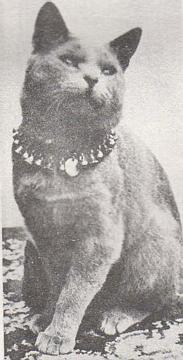Russian Blue breed history
The fairy tale
The infant Princess lay in her cradle, and the fairies brought their gifts
The first gave her a fine, fearless spirit;
the second gave her a loyal, loving heart;
the third said she would be beautiful and slim all her life;
the fourth said her every move would be graceful;
the fifth said she would be always clad in silver, silk and velvet;
the sixth brought her two great glowing emeralds to shine in the dark;
and
the seventh said that wherever she might go all over the world she would
find friends and be much loved.
They were young and unsophisticated fairies and they never realised that the red, squalling creature in the Royal Cot would grow into a lovely Princess. So they laid their gifts in a much humbler cradle, where all was soft warmth and cosy purring. And that is how we came to have the Russian Cat.
The legends
That a
cat might look at a king - or a Queen, or Tsar, if you are to believe the
legends, with Russian Tsars and Queen Victoria being the members of royalty said to be
in thrall to our regal Russian Blue cats. Great stories, but there is
absolutely no proof that they are true, more's the pity....
The facts
What we do know for sure is that Russian Blues in the UK can trace their pedigrees back 30-odd generations to the 1890s and cats imported from Russia by Mrs Constance Carew-Cox, a renowned cat fancier, famous for her Abyssinians, British and Manx cats, as well as her Russian Blues. Some of Mrs Carew-Cox's imported cats who are behind today's Russian Blues include her 'peculiarly lethargic' female, Lingpopo, Olga and Fashoda, via her stud cats, their well-known descendents Bayard and Muchacho, Bayard's son Ivanovitch (born 1904) and Muchacho's son Peter the Great (born 1902).



Bayard, born 1898 Bayard's son Ivanovitch Peter the Great
For such subtle, quiet cats Russian Blues caused an amazing amount of dissent within the cat fancy for decades, with some claiming that Russian and British Blues were one and the same breed, and even the Governing Council deciding at one point that they should not have separate classes at shows. Arguments raged for years about the correct eye colour for Russian Blues, and even though the official standard of points was changed in 1911 to specify that the Russian Blue's eyes should be green, those arguments still continued well into the 1930s. Some cats had their registered breed from Russian to British Blue, and some changed the other way - some cats even won at shows under both breeds! Just to complicate matters further, breeders did not necessarily register their cats, unless they wished to show them in competition.
Although there were a number of very active breeders of Russian Blues in the 1930s, the second World War hit them as hard as all other breeders of pedigree animals. It was difficult enough feeding your human family. As a result, at the end of the war there were only a tiny handful of pedigree Russian Blues left, along with one or two other cats found wandering who were judged to be Russians. Probably the most famous breeder of this time is Miss Marie Rocheford of Dunloe Russian Blues, who managed to gather up enough cats to restart breeding in earnest. However, in the interests of the breed she eventually made the difficult decision to outcross to a blue-point Siamese called Lela Do, who can be found in most Russian pedigrees thanks to his very successful son, Champion Dunloe Domokvitch.
Contrary to some reports this decision to use a Siamese did not 'open the floodgates' to masses of further outcrosses and if you look at photographs of Siamese from the period they bear little resemblance to the typey cats of today. Russian Blues gained valuable genetic diversity, brighter green eyes but, less positively, louder voices and flatter coats. However, breeders put in a lot of effort to keep the positive, and work away from the negative, with the result that today we are producing cats that would still be recognisable as Russian Blues by breeders back in the 19th century.
